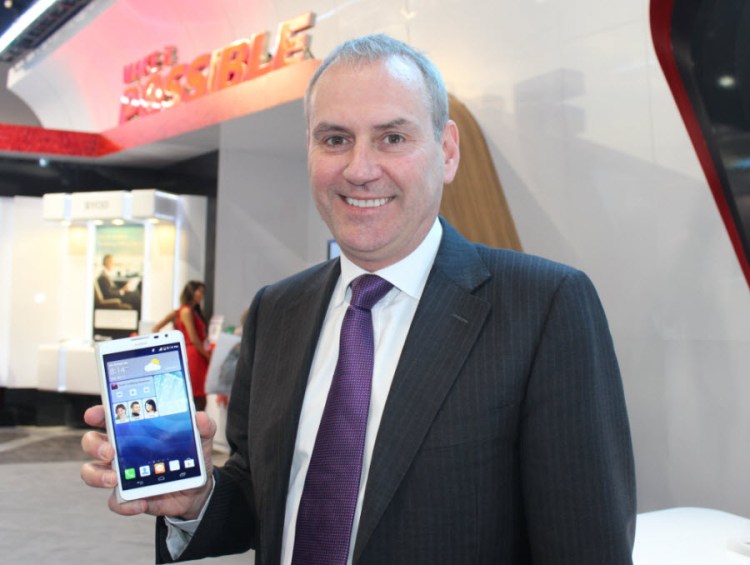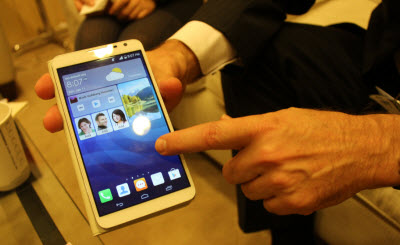China’s emergence as a global tech player is a continuing trend in consumer electronics, and the rise of China’s Huawei is a prime example.
The company wants to be a global brand in tech products and will continue to expand its presence in the U.S. market, Colin Giles, executive vice president at Huawei, told VentureBeat.
Last year, the company showed off a “phablet,” or phone-tablet that was widely ridiculed in the West. But it took off in Asian markets. And this year it was back with a new model that it will push in the U.S.
Huawei’s goal to become a global brand is not a crazy ambition. In 2012, it sold 32 million smartphones. In 2013, it sold 52 million. In 2014, it wants to sell 80 million.
“The average growth of our brand awareness in 30 countries was 100 percent, based on our surveys,” Giles said. “The U.S. is a very important market as a leader of trends. It will be an important market for our company as a trendsetter. But if you look for the growth, you have to look at Asia too.”
China’s presence was certainly huge at the 2014 International CES, the big tech trade show in Las Vegas, where I interviewed Giles. Steve Koenig, senior analyst for the Consumer Electronics Association, said at the show that China has finally eclipsed North America as the largest consumer electronics market in 2013. In smartphones, China has been the largest market for some time.
But North American tech sales are expected to be $257 billion in 2013, once the counting is finished. China’s region is expected to hit $282 billion. Emerging markets are now 50 percent of global tech sales, compared to 40 percent not long ago, Koenig said.
There are 160 cities in China that have more than 1 million people, compared to just nine in the U.S. China’s gross domestic product (GDP), expected to hit 7.4 percent in 2014, is also rising faster than North America’s.
The size of China and its reach was a lot more evident at CES this year than in the past. China’s HiSense occupied some prime convention space in the old Microsoft booth. It reminded me of the days when the Japanese consumer electronics giants dominated, and South Korea’s Samsung was a small upstart on the show floor.
Giles, a former Nokia executive, has spent about 20 years in China, and he joined Huawei six months ago because he believes now is a great time for Chinese companies and the quality of their products.
“Around the world, you’re seeing an acceptance of Asian brands,” Giles said. “Building the brand is important in every market, the U.S. as well as overseas. Being a Chinese company brings its unique set of challenges, and its set of opportunities too.”
Of the many smartphones and tablets that the company showed off at CES, the one that Huawei will push in the U.S. heavily is the Ascend Mate II, a “phablet,” or phone-tablet hybrid, with a 6.1-inch screen.
Last year, such phablets were so new that folks made fun of them as giant phones. But phablets have taken off in Asia. In fact, on Wednesday, Hewlett-Packard announced that it would launch an Android-based phablet in India.
- Huawei’s latest phablet, or phone and tablet.
Even if Huawei’s actual product thrust in the U.S. seems small, everyone should take notice.
On a global basis, Huawei generated $39.6 billion in revenues in 2013, up 11.6 percent from a year ago.
Giles also said that Huawei makes a number of products that U.S. companies put their names on and sell as their own.
“We have historically had close ties to carriers, and we sell into all the carriers here,” Giles said. “We don’t always use the Huawei brand name.”
Huawei is also selling via e-commerce and alternative means of distribution. In Europe, a large percentage of sales in the fourth quarter were via e-commerce outfits like Amazon.
“We’ve also got more investment in innovative products,” Giles said.
Last year, Huawei’s research and development budget was $5.4 billion. The company has 150,000 employees, and many of them are engineers.
Given some recent bad publicity about allegations that Huawei was spying for the Chinese government, some people might be surprised to hear that the company still wants to move into the U.S. market. (Of course, others could say the same about how the National Security Agency spying scandal will hurt U.S. companies abroad).
But Giles said it remains a priority, and the plan to push the Ascend Mate II backs that up. This year’s model has a more efficient battery, and Huawei says its own proprietary technology gives the phablet a 30 percent savings in battery life compared to past models. Faster data transfer and better video experiences are driving demand for phablets, Giles said.
“Large screen phones have been accepted in Asia, but a lot has changed here in the U.S. in the last year as well, and we think it will gain ground,” Giles said. “We are looking at consumers and what will really enhance their experience. A year ago, there was a lot of questioning about a 6.1-inch screen. But the response of our competitors shows a lot more of these devices and a shift in consumer perceptions in the U.S. on this category too.”
VentureBeat's mission is to be a digital town square for technical decision-makers to gain knowledge about transformative enterprise technology and transact. Learn More




![Reblog this post [with Zemanta]](http://img.zemanta.com/reblog_e.png?x-id=068070c6-313b-41fe-ba3d-db5bf3bf695a)
